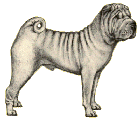

![]() The Chinese
Shar-Pei is a regal, intelligent and dignified dog. He is snobbish and
independent with strangers, but extremely devoted to his family. The Shar-Pei
prefers to be around humans, versus around other dogs and animals.
The Chinese
Shar-Pei is a regal, intelligent and dignified dog. He is snobbish and
independent with strangers, but extremely devoted to his family. The Shar-Pei
prefers to be around humans, versus around other dogs and animals.
![]() The Chinese
Shar-Pei (name literally means "sand-skin") is an ancient breed,
thought to be in existence since the Han Dynasty, around 200 B.C. This
breed is unique in the dog world due to his coat. It is rough and short
. . . a loose translation of the Shar-Pei's name is "sandpaper-like
coat." Another unique characteristic of this breed is his having
a blue-black tongue. The Chow-Chow also has this unique characteristic,
indicating a possible common ancestor to both breeds.
The Chinese
Shar-Pei (name literally means "sand-skin") is an ancient breed,
thought to be in existence since the Han Dynasty, around 200 B.C. This
breed is unique in the dog world due to his coat. It is rough and short
. . . a loose translation of the Shar-Pei's name is "sandpaper-like
coat." Another unique characteristic of this breed is his having
a blue-black tongue. The Chow-Chow also has this unique characteristic,
indicating a possible common ancestor to both breeds.
![]()
![]() The tongue
should be a bluish-black -- a spotted tongue is a major fault according
to the Standard -- unless it is a dilute. If it is a dilute, a lavender
tongue is acceptable. However, a solid pink tongue is a disqualification
as the Standard is written.
The tongue
should be a bluish-black -- a spotted tongue is a major fault according
to the Standard -- unless it is a dilute. If it is a dilute, a lavender
tongue is acceptable. However, a solid pink tongue is a disqualification
as the Standard is written.
![]() The Shar-Pei
can be a number of colors, but the coat must be solid in color. Colors
include black, cream, fawn, red-fawn, red, sable, apricot, chocolate,
isabella and blue. Dilute coloration is when the nose, nails and anus
of the dog is the same color as the coat. In other words, a chocolate
coated dilute Shar-Pei would have a chocolate colored nose, nails and
anus. The nose color may be black or "brick" (pink with black)
with or without a black mask.
The Shar-Pei
can be a number of colors, but the coat must be solid in color. Colors
include black, cream, fawn, red-fawn, red, sable, apricot, chocolate,
isabella and blue. Dilute coloration is when the nose, nails and anus
of the dog is the same color as the coat. In other words, a chocolate
coated dilute Shar-Pei would have a chocolate colored nose, nails and
anus. The nose color may be black or "brick" (pink with black)
with or without a black mask.

![]() The Chinese
Shar-Pei was imported to the United States in 1966, but it wasn't until
1973 that many people exhibited an interest in the breed. The Shar-Pei
gained full AKC recognition in the Non-Sporting Group, in 1992.
The Chinese
Shar-Pei was imported to the United States in 1966, but it wasn't until
1973 that many people exhibited an interest in the breed. The Shar-Pei
gained full AKC recognition in the Non-Sporting Group, in 1992.
![]()
![]() Possible health
concerns in the Chinese Shar-Pei breed are:
Possible health
concerns in the Chinese Shar-Pei breed are:
- Entropion - an eye condition in which the eyelid rolls in towards the eye. The eyelashes or hair on the eyelid can rub against the cornea causing irritation and possibly corneal ulcers. Surgery is required to correct this problem
- Hypothyrodism - displays a wide variety of symptoms ranging from dull thin hair to ear infections. Blood test required to determine if present. (Low thyroid production)
- Familial Shar-Pei Fever - a recurrent episodic fever disorder where an unexplained fever of 103-107 degrees is present. The fever episodes generally start at about 18 months of age; most fevers last 24-36 hours without treatment.
- Demodectic Mange - skin condition caused by a tiny mite, too small to be seen without a microscope. Usually aquired from mother shortly after birth.
- Seborrhea - yellow to yellow-brown scales, greasy coat and skin, itchy skin, skin infections and a rancid odor.
- Malocclusion - most common form in Shar-Pei's is that of an overbite.
- Tight Lip Syndrome - usually associated with an overbite. Excess flesh from the lower lip covers the lower front teeth, making it difficult to chew (in overbite). Trapped food particles can lead to inflammation. In many case, tight lip syndrome is surgically correctable.
- Stenotic Nares - collapsed nostrils.
- Hip Dysplasia - an abnormality of the hip joint, ranging in severity from mild (controllable pain levels) to severe (dog must be put down). The OFA (Orthopedic Foundation for Animals) is an evaluation organization. Be sure parents of any puppy -- regardless of breed -- has been cleared by the OFA.
- Patellar Luxation - dislocation (slipping) of the patella (kneecap) out of its socket. It can be the result of injury or congenial (present at birth) deformities. Can affect one or both rear legs.